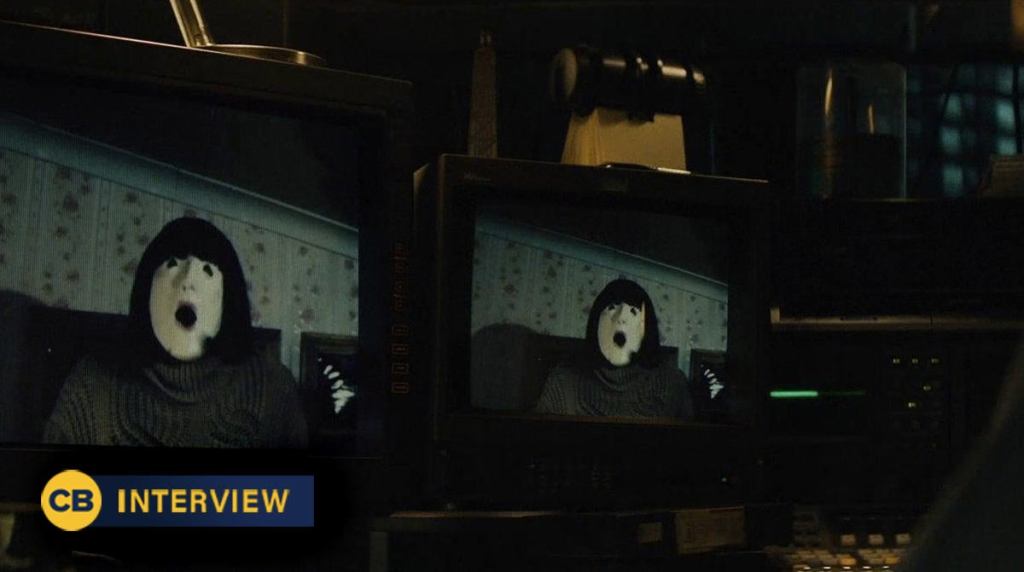In November of 1987, Chicago’s WGN-TV had their broadcast hijacked by a mysterious, masked figure, sporting a disguise from the TV series Max Headroom. Two of these “broadcast intrusions” occurred, both of which featured bizarre and distorted dialogue, and while these are the most famous such incidents, the event remains unsolved to this day. The new film Broadcast Signal Intrusion, from director Jacob Gentry, was inspired by these incidents, but takes things down a much more frightening path, confirming that the answer to such a mystery might be more unsettling than leaving it unanswered. Broadcast Signal Intrusion hits theaters and Digital HD on October 22nd.
Videos by ComicBook.com
In the film, “While logging tapes of decades-old TV broadcasts, video archivist James (Harry Shum Jr.) discovers a surreal and disturbing clip that James believes is the product of a mysterious broadcast signal hacking. His discovery takes a sinister turn when he tracks down similar broadcast intrusions that send him on an obsessive mission. Now James must confront two very real possibilities: that the videos may be clues to a crime beyond all comprehension; and that whoever was behind them may be very aware that James is coming uncomfortably close to the truth.”
ComicBook.com caught up with Gentry to talk the real-life inspiration for the project, the unsettling intrusions from the film, and determining the difference between reality and fantasy.

ComicBook.com: I remember when I first learned about the Max Headroom incident and the impact it left on me, so for you, do you remember when you had first learned about it and what impact did that real-life incident have on this film both tonally and narratively?
Jacob Gentry: Well, first of all, I think that what’s fascinating about the Max Headroom incident specifically is that, unlike other broadcast intrusions, it’s unsolved, and until you dig in … I mean, unsolved mysteries just in general are always really interesting, and that’s why we still talk about that one. But it’s also like, before you really dig into what broadcast intrusions actually are, you’re like, “Well, how was this unsolved?” We live in a world where there’s so much metadata with everything that, the idea that you could create something and it not be able to be tracked, seems archaic. It’s just fascinating because it’s one of those things that’s really creepy, but you can’t really put your finger on why, you know what I mean?
That was how, the first time I read the original script, that’s how I felt about that, too. Which was, I don’t know why I’m so freaked out about this, and I’m not squeamish, I don’t really get freaked out much, especially with horror scripts, and I got freaked out. I was also a huge fan. I mean, just selfishly I was also a huge fan of the Max Headroom TV show. Did you ever see that? It’s like an apocalyptic dystopia.
You worked with writers Phil Drinkwater and Tim Woodall, who previously turned this idea into a short and directed it, so when it came to expanding it into a feature, how did you aim to honor that source material while also putting your own mark on the visual style of the feature?
Well, to be honest with you, I didn’t actually know that it was based on it. I didn’t know that they made a short film when I got involved, and I actually think I might have been a little bit more hesitant. Just because I have so much respect for directors and stuff like that, but ultimately, by the time I was already involved in it and it seemed like my take and all the things that I wanted to do with it, were not necessarily informed by anything other than the material. I think that having, eventually, seen some of the original stuff, I did see like, “Oh, well, I think it got it some of the same places through different roots,” if that makes sense. I also wanted to put my own spin on it.
I know that the writers, perhaps they had some conspiracy, ’70s, paranoia-thriller inspirations, but we didn’t really discuss that. We had lots of script meetings, we were developing the script and pushing certain things further and whatnot. Things that just were of my interest levels in the thing that I wanted to push further, and in doing that, it felt like there was … Essentially just trying to make it your own while also just trying to be true to like, whatever the spirit of the material was.
This movie starts in Chicago but then heads to lesser-known towns in Illinois, like Joliet or Peoria. Was that meant to be a nod to the original Max Headroom incident and how it happened in Chicago or were there other elements of the story that you think made it so Chicago and the geography of the state were integral to the story or look of the film?
Well, the script that I originally had read to get involved with the movie actually was not set anywhere specifically, and it had very much The Max Headroom Incident in the DNA. But when I got involved, they’re UK writers, so it was definitely told in more of an “every city,” a little bit more of a metaphorical sense to everything.
I was just like, “Let’s just double down on this, and since we’re already shooting in Illinois, let’s actually really utilize that.” So just a matter of, with the crew and the collaborators just trying to really make things as specific as possible to that city, and try to make it almost like a historical fiction of The Max Headroom Incident as opposed to something that is loosely … It just gives it a little more specificity and, in that way, it can feel like it actually could be a true story. I’ve actually had people be like, they didn’t know anything about it, they’re like, “Is this based on a true story?” And it’s like, “No, but there’s a lot of inspiration taken from it.”
I hadn’t been to Chicago that much, it was great. I looked at it like, this is just the most photogenic city in the world and I wanted to get the feeling of it. So that was really the thing, is I wanted to get that feeling. So then I was able to go back and go, “Okay, Peotone, this is where this amazing location that we’ve found, which is the best horror movie house of all time,” like no production design required and it was in Peotone. So we actually worked that in and just tried to make it really specific so people would have fun with it.
Could you talk a bit about the intrusions themselves, and just the collaborative process of bringing them to life? They felt similar to the Max Headroom footage but also gave me a Shaye Saint John vibe, so I wondered how those came about.
That was just a lot of conversations [with Dan Martin], some of our big inspiration from that was this creepypasta called “Tara the Android,” and that was something we started working on essentially finding what’s really creepy about that. And what’s really creepy about that is the mundanity of the whole thing. It’s the most unnerving thing in the world, it’s just this robot-like entity, standing in a room, really benign everything, just singing, “I feel fantastic,” and that’s actually the title of it.
The Shaye Saint John thing was actually something that, after we started working towards the “I feel fantastic” Tara the Android thing, then I discovered that whole theory about that being one of the suspects in the intrusion. It was very encouraging, to keep going deeper into this whole thing. Working with Dan was really great. He is just a boundlessly imaginative artist and James Swanson, who was the actor who played both the guy in the mask and also some of the robot, there were some animatronics, but there was also some actually him moving. He has a very Doug Jones-esque body and he can pop and lock with the best of him.
WARNING: Minor spoilers below for Broadcast Signal Intrusion
The ending of the movie and a lot of things that happen along the way, could you talk a little bit about finding that line between what’s really happening from a narrative standpoint vs. what the audience is seeing happen but is actually just from the perspective of the protagonist? Was there an exact moment where things went from reality into the character’s fractured mental state or is there no real definition for it all?
Formalistically speaking, it was really just about Scott Teal, the cinematographer, and I were talking a lot about how, when you play a tape over and over and over again, it starts to degrade, basically like videotapes degrade, or when you copy over and over it. As the movie goes on, it starts to come apart a little bit. We shot the opening very formalistically and fluidly, and then as you get towards the end of the movie, it starts to unwind and be a little more chaotic in the filmmaking. But I think there’s also the questioning of dreams and reality, because when you’re just exposed to so much media, you start to lose it, and then that media starts to inform your dreams.
It’s hard to find the root point of everything, and everything just becomes this “time is a flat circle” idea, just reflecting this psyche of the main character, and that also, with Ben Lovett’s music, he actually recorded the entire score and then would run it through video recorders to degrade the sounds and give it an analog feel, add the sound effects of the VHS tape, which is just naturally scary. We’d thought, “Why is a VHS tape so good for horror movies?” But yeah, I don’t know if that answers your question.
It does add some more insight into the overall experience, that the further the audience gets, the further the protagonist gets, the harder it is to differentiate what is “real” and what isn’t, as opposed to there necessarily being one event or one encounter that signals that shift from being more linear to being more hallucinatory?
Well, actually, I know how to answer that, is that basically there is a turning point, as far as I’m concerned. There’s a couple of them where they’re massive turning points that almost work in an almost traditional story structure sense, but because the movie is about connecting dots that may or may not be there, and it’s a conspiracy thriller, that’s also questioning the idea of conspiracies and conspiracy theorists in the first place, and it becomes a character study. It’s a very first-person, subjective movie, from his point of view. So it’s almost as if you could potentially miss those turning points because you’re missing them in the same way that he is. He’s not noticing certain things that could be helpful to both the mystery he’s trying to solve and also his own psyche.
I do think it does, in my mind, eventually becomes almost like a character study about why you would even be so obsessed with something like this, you know what I mean? And why do you feel like you believe that there is a connection between your trauma of the loss of your wife and these broadcast signal intrusions. So it’s in there, and I think if one were inclined to re-watch the movie, it might be fun to try to find those turning points, where it’s like, “Oh, my gosh, if he hadn’t have done that, there’d be no movie.”
Broadcast Signal Intrusion hits theaters and Digital HD on October 22nd.
This interview has been edited for length and clarity. You can contact Patrick Cavanaugh directly on Twitter.








